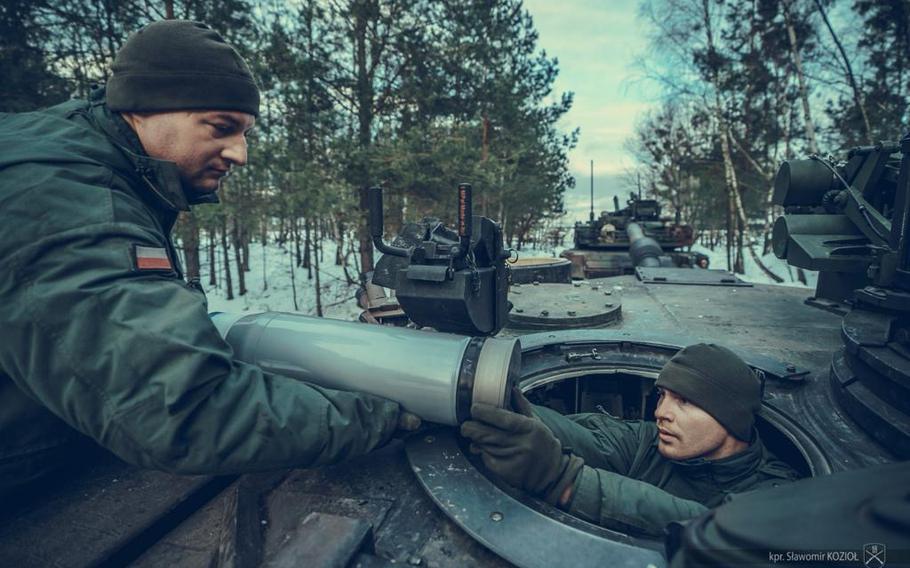
Polish soldiers load rounds onto an Abrams tank Jan. 16, 2024, during crew gunnery qualifications at Nowa Deba Training Area, Poland. The tank crew, which is taking part in live-fire drills this week, became the first in the Polish military to qualify on a U.S. Abrams tank. (Polish armed forces)
A U.S. armored unit’s deployment near Poland’s border with Ukraine culminated this week with a joint live-fire drill that has Polish tank crews testing their aim on their new Abrams tanks.
It put a capstone on months of training that saw a Polish tank crew qualify on the Abrams, becoming the first to do so, soldiers from the Army’s 1st Battalion, 35th Armored Regiment said Tuesday.
The collaboration also broke new ground for an Army mission that is still getting established in the small Polish town of Nowa Deba.
“We’re the first American unit to be here for the entire rotation,” said Lt. Col. William Baker, commander of the battalion based at Fort Bliss, Texas. “And so it was kind of this blank canvas that we had to figure out what we can do in terms of NATO partnership, what we can do in terms of building relationships.”
The battalion, part of the 2nd Armored Brigade Combat Team, 1st Armored Division, is slated to wrap up its nine-month deployment around March, and Baker said there’s a sense of urgency.
The unit is part of the expanded American military mission along NATO’s eastern flank that was put in place following Russia’s full-scale invasion of Ukraine nearly two years ago.
During their time in Nowa Deba, blasting rounds on the range has been a top priority for a twofold mission: deterring Russian aggression and enhancing the fighting capabilities of ally Poland.
To bolster that effort, the soldiers incorporated Polish platoons into two of the battalion’s tank companies. The aim was to get the Poles better acquainted with the finer points of operating and maintaining the Abrams tank, which Warsaw is incorporating into its ground force as part of a multibillion-dollar modernization push.
While Polish troops received initial training on the Abrams from General Dynamics teams, that didn’t address all their training needs, Baker said.
Polish Lt. Col. Marcin Wdowiak, whose soldiers have been partnered with the Americans, said one valuable aspect of the Abrams is its nuclear, biological and chemical protection system.
Such a system is relevant given the uncertainty surrounding what’s happening in Ukraine, he said.
“You must be prepared for everything,” Wdowiak said.
Baker hopes the program can be a model for future U.S. units rotating into Poland.
Training in Nowa Deba has presented challenges for the Americans because the ranges are smaller and have less room to maneuver than they are accustomed to at bases in the United States, soldiers said.
For example, the ability to shoot on the move with moving targets is more limited, said 1-35 Command Sgt. Maj. Efrain Flores.
“You lose a lot of that ability here, as well as the depth of the range,” he said.
But for 1-35’s newest tanker recruits, the ranges at Nowa Deba have provided a good foundation to build from as they prepare for their return to Fort Bliss, he said.
The border with Ukraine is only about 80 miles away, so conveying the importance of the mission to the soldiers has been easy, Baker said.
“We didn’t just come over here because we’re doing maintenance and we’re shooting gunnery,” Baker said. “There’s a real need.”
The deployment also brings tangible focus about the purpose of NATO, which can be something of a political abstraction for soldiers, he said.
“Often we think about NATO in terms of diplomatic and high-level security talks,” Baker said. “What’s real for us down here is that we’ve got a Polish unit with us that we’re training with day in and day out.
“We’ve been in the field day and night together. And that’s really what NATO is for us.”